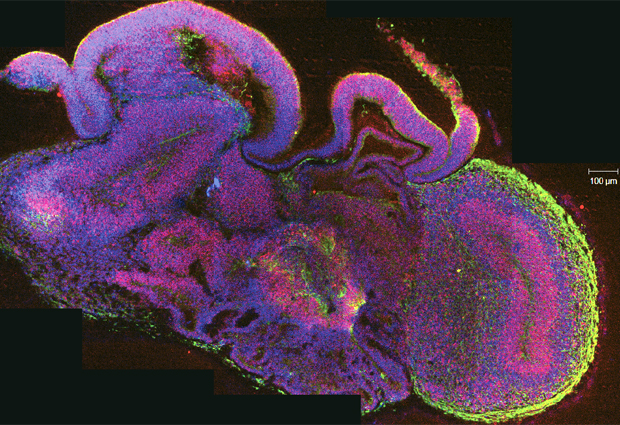
Using mini brains to understand big brains
What opportunities can organoids bring to further the understanding of the human brain?

Ahead of the “Tissue Self-Organisation: Challenging the Systems” conference, speaker Madeline Lancaster shares how curiosity and serendipity culminated in her pioneering method to grow cerebral organoids. These miniaturised and simplified versions of the human brain produced in the lab are now used by researchers around the world.
What unsolved question would you like to answer?
I want to learn what makes us human. We are very intelligent animals and I think our exceptional intelligence stems from the unique characteristics of the human brain. When compared to other animals’, the human brain has unique cell types, is bigger than expected and contains more neurons – almost a hundred billion neurons in a 1.3 kg brain. I am especially interested in the early events that determine what types of cells are made and how many, because I believe this is what sets the human brain apart. Obviously, it’s quite difficult to study how the brain works and its development in living animals. This has compelled scientists to find alternative ways to study it – like cerebral organoids.
I want to learn what makes us human
How did you first create brain organoids?
It was a clear case of serendipity. I was a post-doc in Juergen Knoblich’s lab in Vienna and I wanted to grow mouse neural stem cells to see the effect that genes previously found in flies had in mouse neural stem cell identity. To do so, I cultivated stem cells in a dish using a method called neural rosettes, where the stem cells stick to the dish and grow in a 2D fashion. But my cells didn’t stick. They just floated off making these really interesting balls of tissue. So I had two projects running. The official one, trying to create neural rosettes – which I did in the end – while on the side I played with the balls of tissue that formed when the neural rosettes didn’t work. I knew that people making intestinal organoids cultivated them in Matrigel, so I decided to put my little weird balls of tissue in Matrigel, too, just to see what would happen. And they became amazingly complex 3D structures! The first time I opened the incubator, looked in the dish and saw an organoid with all of its beautiful structures, I was incredibly awed by it.

What are the limitations of using organoids?
Cerebral organoids model development very well. They are great for looking at the generation of neurons and how neural stem cells behave. Unfortunately, there are some major limitations once the neurons are made – it’s not the same to have brain tissue growing in a dish as growing in a head. So, neurons mature to some degree, but there’s no proper neural network forming the connections found in an actual brain. I don’t think we will ever end up with a fully formed human brain in a dish – and we don’t want to – because of the limitations of not having a cardiovascular system. But cerebral organoids can still be improved and I believe some of the limitations will be overcome with creative bioengineering approaches. For specific questions – like the interaction of the vascular system with the brain barrier or the crossing of drugs across the blood-brain barrier – tweaks in the method will allow for new avenues of investigation.
What do you think the field will look like in 15 years?
We are still far from realising organoids’ full potential, because it’s a relatively new method and there’s still so much to do in terms of model characterisation. At the same time, I think they are already having a big impact. In the future, organoids will be the go-to tool for studying human brain biology, from development to function and disease – especially those diseases that are specific to humans, like autism or microcephaly. Potentially, brain organoids can also provide insight into drug therapy development. I think it’s going to evolve into different subfields where people will use organoids in different ways, providing insight into different questions.
Madeline Lancaster leads a lab at the Cell Biology Division of the Medical Research Council (MRC) Laboratory of Molecular Biology, part of the Cambridge Biomedical Campus, UK, where she uses cerebral organoids to better understand human brain development.

Some of the most fascinating questions in science are about origins. As part of our latest editorial theme, we’re exploring the idea of origins at EMBL. We want to talk about the origins of biological systems, about our people and the paths that brought them here, and the discoveries and ideas that have their origins here.


